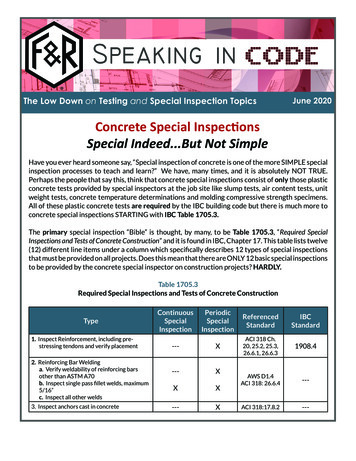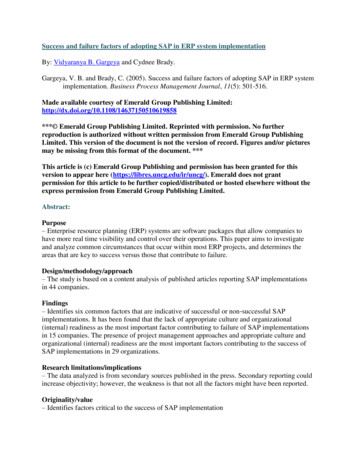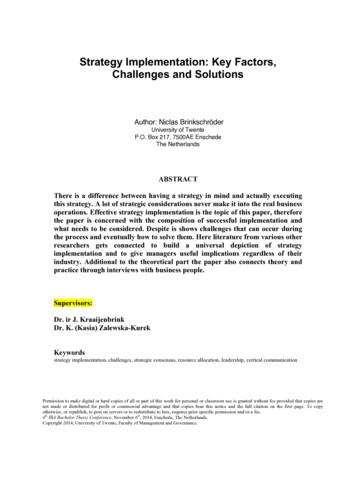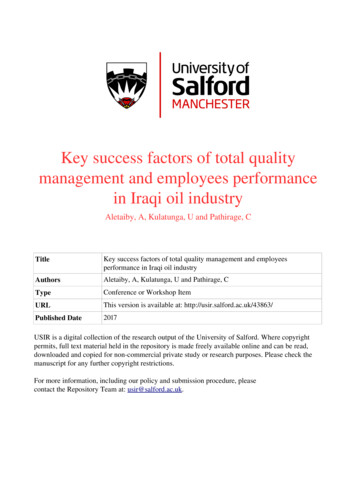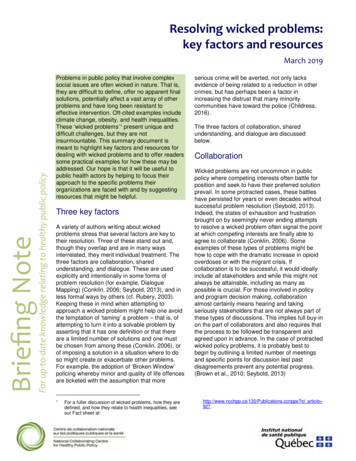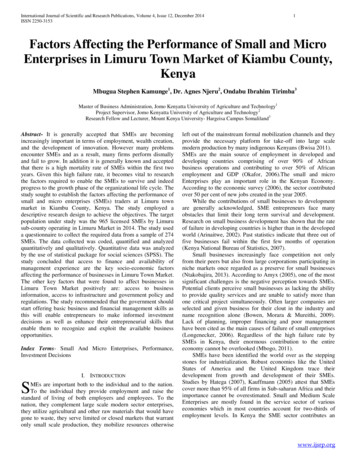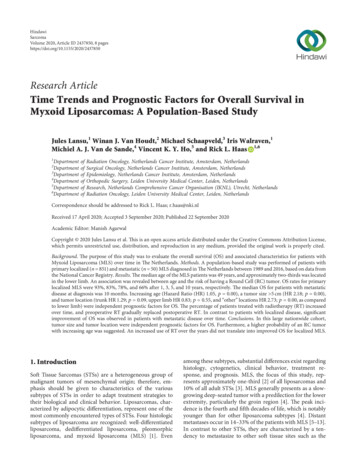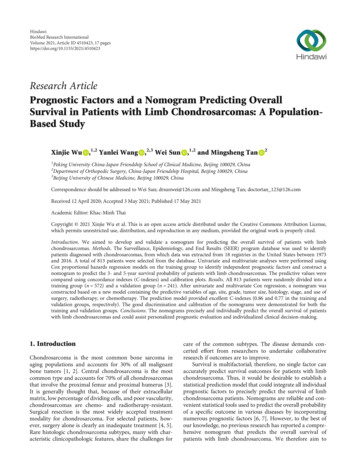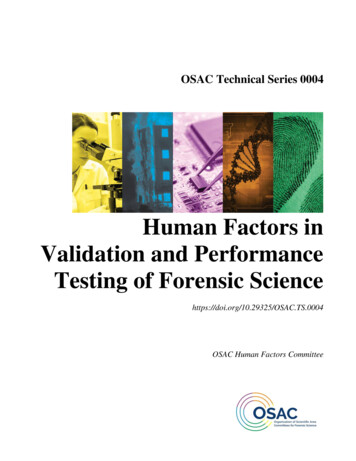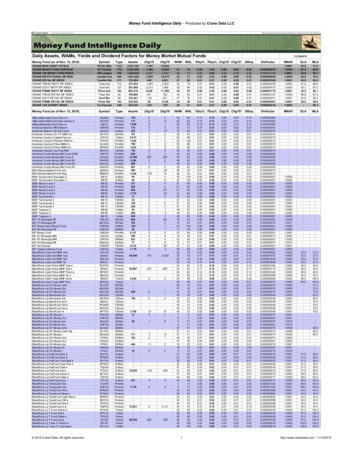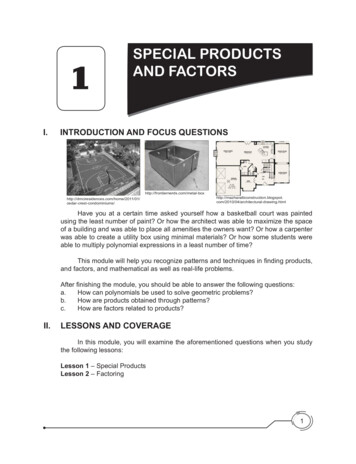
Transcription
SPECIAL PRODUCTSAND FACTORSI.INTRODUCTION AND FOCUS 2010/04/architectural-drawing.htmlHave you at a certain time asked yourself how a basketball court was paintedusing the least number of paint? Or how the architect was able to maximize the spaceof a building and was able to place all amenities the owners want? Or how a carpenterwas able to create a utility box using minimal materials? Or how some students wereable to multiply polynomial expressions in a least number of time?This module will help you recognize patterns and techniques in finding products,and factors, and mathematical as well as real-life problems.After finishing the module, you should be able to answer the following questions:a.How can polynomials be used to solve geometric problems?b.How are products obtained through patterns?c.How are factors related to products?II.LESSONS AND COVERAGEIn this module, you will examine the aforementioned questions when you studythe following lessons:Lesson 1 – Special ProductsLesson 2 – Factoring1
In these lessons, you will learn to:Lesson 1SpecialProductsLesson 2Factoring identify polynomials which are special products through patternrecognitionfind special products of certain polynomialsapply special products in solving geometric problemssolve problems involving polynomials and their productsfactor completely different types of polynomialsfind factors of products of polynomialssolve problems involving polynomials and their factors.Module MapMapModuleHere is a simple map of the lessons that will be covered in this module:Special ProductsFactoringSquare of a BinomialCommon Monomial FactorDifference of Two SquaresSquare of a TrinomialPerfect Square TrinomialSum and Difference of TwoTermsGeneral TrinomialCube of a BinomialSum and Difference of TwoCubesGroupingApplicationsFind out how much you already know about this module. Write the letter thatcorresponds to the best answer on your answer sheet.2
III. PRE-ASSESSMENT1.Which mathematical statement is correct?a.b.c.d.2.Which of the following DOES NOT belong to the group?a.b.c.d.3.x2 – 0.0001y48(x – 1)3 – 27(x 1)4 – 4x6(x 1)(x 4)(x 2)(x 2)(x 5)(x – 1)(x 2)2A polynomial expression is evaluated for the x- and y-values shown in the tablebelow. Which expression gives the values shown in the third column?a.b.c.d.5.1 4x –14Which of the following gives a product of x2 5x 4?a.b.c.d.4.6x2 – 5xy y216x2 –40x 256x2 13x – 284x2 20x 25XY0-1110-11-1x2 – y2x2 2xy y2x2 – 2xy y2x3 – y3Find the missing terms: (x )(3x ) 3x2 27x 24a.b.c.d.6, 44, 68, 312, 23Value of theExpression0004
6.The length of a box is five meters less than twice the width. The height is 4 metersmore than three times the width. The box has a volume of 520 cubic meters.Which of the following equations can be used to find the height of the box?a.b.c.d.7.One of the factors of 2a2 5a – 12 is a 4. What is the other factor?a.b.8.c.d.2a – 82a 8(3x 2) units(2x 3) unitsc.d.(4x 9) units(4x 3) unitsThe side of a square is x cm long. The length of a rectangle is 5 cm longer thanthe side of the square and the width is 5 cm shorter. Which statement is true?a.b.c.d.10.2a – 32a 3The area of a square is 4x2 12x 9 square units. Which expression representsthe length of the side?a.b.9.W(2L – 5) (3H 4) 520W(2W 5) (3W – 4) 520W(2W – 5) (3W – 4) 520W(2W – 5) (3W 4) 520The area of the square is greater than the area of the rectangle.The area of the square is less than the area of the rectangle.The area of the square is equal to the area of the rectangle.The relationship cannot be determined from the given information.A square piece of land was rewarded by a landlord to his tenant. They agreed thata portion of it represented by the rectangle inside should be used to construct agrotto. How large is the area of the land that is available for the other purposes?25 – 2x2x – 1a.b.c.d.4x2 – 94x2 x 94x2 – 8x – 94x2 92x – 111.Which value for x will make the largest area of the square with a side of 3x 2?3a.4 c.b.0.4d.4130.15
12.Which procedure could not be used to solve for the area of the figure below?x 82x 62xa.1(2x)(x 8)2A 4x2 12x x2 8xA 2x (2x 6) A 5x2 20xb.1)(x)(x 8)2A 6x2 28x – x2 – 8xA 2x(3x 14) – 2(A 5x2 20xc.1)(x)(x 8)2A [4x2 12x) (2x2 16x) – (x2 8x)A [2x(2x 6) (x 8)(2x)] – 2(A 6x2 28x – x2 – 8xA 5x2 20xd.1)(2 x)(x 8)2A 4x2 12x x2 8xA 2x(2x 6) (A 5x2 20x13.Your classmate was asked to square (2x – 3), he answered 4x2 – 9. Is his answercorrect?a.b.c.d.14.Yes, because squaring a binomial always produces a binomial product.Yes, because the product rule is correctly applied.No, because squaring a binomial always produces a trinomial product.No, because the answer must be 4x2 9Let A: 4x2 – 81, and let B: (2x – 9)(2x 9). If x 2, which statement is true aboutA and B?a.A Bb.A Bc.5A Bd.A B
15.Your sister plans to remodel her closet. She hired a carpenter to do the task. Whatshould your sister do so that the carpenter can accomplish the task according towhat she wants?a.b.c.d.16.Which of the following standards would best apply in checking the carpenter’swork in item number 15?a.b.c.d.17.Feasibility and budgetDesign and budgetDesign and FeasibilityBudget and lot areaSuppose there is a harvest shortage in your farm because of malnourished soil.What will you do to ensure a bountiful harvest in your farmland?a.b.c.d.19.accuracy of measurements and wise utilization of materialsaccuracy of measurements and workmanshipworkmanship and artistic designworkmanship and wise utilization of materialsThe city mayor asked you to prepare a floor plan of the proposed day care centerin your barangay. The center must have a small recreational corner. As head ofthe city engineering office, what will you consider in preparing the plan?a.b.c.d.18.Show a replica of a closet.Download a picture from the internet.Leave everything to the carpenter.Provide the layout drawn to scale.Hire number of workers to spread fertilizers in the farmland.Buy several sacks of fertilizers and use them in your farmland.Find the area of the farmland and buy proportionate number of sacks offertilizers.Solve for the number of sacks of fertilizers proportionate to the number ofworkers.The Punong Barangay in your place noticed that garbage is not properly disposedbecause the garbage bins available are too small. As the chairman of the healthcommittee, you were tasked to prepare garbage bins which can hold 24 ft3 ofgarbage. However, the location where the garbage bins will be placed is limited.H ow will you maximize the area?a.b.c.d.Find the dimensions of the planned bin according to the capacity given.Make trial and error bins until the desired volume is achieved.Solve for the volume and use it in creating bins.Find the area of the location of the bins.6
20.As head of the marketing department of a certain construction firm, you aretasked to create a new packaging box for the soap products. What criteria will youconsider in creating the box?a.b.c.d.Appropriateness and the resources usedResources used and uniquenessAppropriateness and uniquenessAppropriateness and capacityHow was your performance in the pre–test? Were you able to answer all theproblems? Did you find difficulties in answering them? Are there questions familiar to you?IV. LEARNING GOALS AND TARGETSIn this module, you will have the following targets: Demonstrate understanding of the key concepts of special products and factors ofpolynomials.Formulate real-life problems involving special products and factors and solvethese with utmost accuracy using a variety of strategies.7
Lesson1SpecialProductsWhat toto KnowKnowWhatLet us start our study of this module by reviewing first the concepts on multiplyingpolynomials, which is one of the skills needed in the study of this module. Discuss thequestions below with a partner.PATTERNS WHERE ARE YOU?Have you ever looked around and recognized different patterns? Have you askedyourself what the world’s environment would look like if there were no patterns? Why do youthink there are patterns around us?Identify the different patterns in each picture. Discuss your observations with a i-and-being-aplant-1-of-3.htmlHave you ever used patterns in simplifying mathematical expressions? What advantageshave you gained in doing such? Let us see how patterns are used to simplify mathematicalexpressions by doing the activity below. Try to multiply the following numerical expressions.Can you solve the following numerical expressions mentally?97 103 25 25 99 99 99 Now, answer the following questions:1.2.3.What do you notice about the given expressions?Did you solve them easily? Did you notice some patterns in finding their answers?What technique/s did you use? What difficulties did you encounter?The indicated products can be solved easily using different patterns.8
Are your solutions different from your classmates? What did you use in order to find theproducts easily?The problems you have answered are examples of the many situations where we canapply knowledge of special products. In this lesson, you will do varied activities which willhelp you answer the question, “How can unknown quantities in geometric problemsbe solved?”Let’s begin by answering the “I” portion of the IRF Worksheet shown below. Fill it up bywriting your initial answer to the topical focus question:A ctivity 1 IRF WORKSHEETDescription:Direction:Below is the IRF worksheet which will determine your prior knowledge aboutthe topical question.Answer the topical questions: (1) What makes a product special? and (2)What patterns are involved in multiplying algebraic expressions? Writeyour answer in the initial part of the IRF worksheet.IRF WorksheetInitial AnswerRevised AnswerFinal AnswerA ctivity 2Description:Directions:COMPLETE ME!This activity will help you review multiplication of polynomials, the pre-requisiteskill to complete this module.Complete the crossword polynomial by finding the indicated products below.After completing the puzzle, discuss with a partner the questions that follow.123Across Down1.4.5.6.9.11.12.(a 3)(a 3)(b 4a)22a(-8a 3a)(b – 2)(b – 4)-2a(b 3 – 2a)(5b2 7a2)(-5b2 7a2)(a – 6b)(a 6b)1.2.3.5.7.8.10.(a 9)(a – 9)(3 a b)2(3b – 4a)(3b – 4a)(-4a b)(4a b)(2 – a)(4 – a)(4a3 – 5b2)(4a3 5b2)(2a 6b)(2a – 6b)9456811791012
?1.2.3.NSQUES TIOA ctivity 3GALLERY WALKDescription:Direction:This activity will enable you to review multiplication of polynomials.Find the indicated product of the expressions that will be handed to yourgroup. Post your answers on your group station. Your teacher will give youtime to walk around the classroom and observe the answers of the othergroups. Answer the questions that follow.Remember:To multiply polynomials: a(b c) ab ac (a b)(c d) ac ad bc bdQU?NSES TIOHow did you find each indicated product?Did you encounter any difficulty in finding the products? Why?What concept did you apply in finding the product?1.2.3.4.CASE 1:CASE 2:(x 5)(x – 5) (a – b)(a b) (x y)(x – y) (x – 8)(x 8) (2x 5)(2x – 5) (x 5)(x 5) (a – b)2 (x y)(x y) (x – 8)2 (2x 5)(2x 5) CASE 3:CASE 4:(x 5)3 (a – b)(a – b)(a – b) (x y)3 (x 4)(x 4)(x 4) (x 2y)3 (a b c)(a b c) (x y z)(x y z) (m 2n – 3f)2 How many terms do the products contain?Compare the product with its factors. What is the relationshipbetween the factors and the terms of their product?Do you see any pattern in the product?How did this pattern help you in finding the product?10
You just tried finding the indicated products through the use of patterns. Are thetechniques applicable to all multiplication problems? When is it applicable and when is it not?Let us now find the answers by going over the following section. What you will learn inthe next sections will enable you to do the final project. This involves making a packaging boxusing the concepts of special products and factoring.Let us start by doing the next activity.What toto ProcessProcessWhatYour goal in this section is to learn and understand key concepts related to findingspecial products. There are special forms of algebraic expressions whose products arereadily seen. These are called special products. There are certain conditions whichwould make a polynomial special. Discovering these conditions will help you find theproduct of algebraic expressions easily. Let us start in squaring a binomialThe square of a binomial is expressed as (x y)2 or (x y)(x y) and (x – y)2 or(x – y)(x – y). In your previous grade, you did this by applying the FOIL method, which issometimes tedious to do. There is an easier way in finding the desired product and that is whatwe will consider here.A ctivity 4 FOLD TO SQUAREDescription:Directions:In this activity, you will model the square of a binomial through paper folding.Investigate the pattern that can be produced in this activity. This pattern willhelp you find the square of a binomial easily. You can do this individually orwith a partner.Get a square paper measuring 8” 8”.1.Fold the square paper 1” with from an edge and make a crease.2.Fold the upper right corner by 1” and make a crease.3.Unfold the paper.4.Continue the activity by creating another model for squaring a binomialby changing the measures of the folds to 2 in. and 3 in. Then answerthe questions below.7x1yRemember:7x Area of square s2 Area of rectangle lwy111
?1.NSQUES TIO2.3.4.5.How many different regions are formed? What geometric figures areformed? Give the dimensions of each region?What is the area of each region?What will be the area if the longer part is replaced by x? by x and 1?What is the sum of the areas? Write the sum of areas in the boxbelow.If 1 is replaced by y, what will be the area?FIRST TERMSECOND TERMLAST TERM(x 1)(x 2)2(x 3)2(x y)22Did you find any pattern? What pattern is it?1.2.3.How is the first term of the product related to the first term of the given binomial?How is the last term of the product related to the last term of the given binomial?What observation do you have about the middle term of the product and theproduct of the first and last terms of the binomial?Observe the following examples:a.(x – 3)2 (x)2 – 3x – 3x (3)2 x2 – 2(3x) 9 x2 – 6x 9c. (3x 4y)2 (3x)2 12xy 12xy (4y)2 9x2 2(12xy) 16y2 9x2 24xy 16y2b.(x 5)2 (x)2 5x 5x (5)2 x2 2(5x) 25 x2 10x 25Remember: Product rule(am)(an) am n Raising a power to a power(am)n amn12
The square of a binomial consists of:a.the square of the first term;b.twice the product of the first and last terms; andc.the square of the last term.Remember that the square of a binomial is called a perfect square trinomial.LET’S PRACTICE!Square the following binomials using the pattern you have just learned.1.(s 4)25.(3z 2k)29.2.(w – 5)26.(5d – 7d2t)210.4kj – 6)25[(x 3) – 5]2((7q2w2 – 4w2)224.(2q – 4)28.( e – 6)22The square of a binomial is just one example of special products. Do the next activity todiscover another type of special product, that is squaring a trinomial.3.(e – 7)2A ctivity 5Description:Directions:7.DISCOVER ME AFTER!(PAPER FOLDING AND CUTTING)In this activity you will model and discover the pattern on how a trinomial issquared, that is (a b c)2. Investigate and observe the figure that will beformed.Get a 10” 10” square paper. Fold the sides 7”, 3” and 1” vertically and makecreases. Using the same measures, fold horizontally and make creases.The resulting figure should be the same as the figure below.731a13bc
QU?NSES TIO1.2.3.4.5.6.How many regions are formed? What are the dimensions of eachregion in the figure?What are the areas of each region?If the side of the biggest square is replaced by a, how will yourepresent its area?If one of the dimensions of the biggest rectangle is replaced by b,how will you represent its area?If the side of the smaller square is replaced by c, how will yourepresent its area?What is the sum of the areas of all regions? Do you observe anypattern in the sum of their areas?Observe the following examples and take note of your observation.a.b.c.(x y z)2 x2 y2 z2 2xy 2yz 2xz(m n – d)2 m2 n2 d2 2mn – 2md – 2nd(3d 2e f)2 9d2 4e2 f2 12de 6df 4efThe square of a trinomial consists of:a.the sum of the squares of the first, second and last terms;b.twice the product of the first and the second terms;c.twice the product of the first and the last terms; andd.twice the product of the second and the last terms.LET’S PRACTICE!Square the following trinomials using the pattern you have learned.1.(r – t n)26.(15a – 4n – 6)22.(e 2a q)27.(4a 4b 4c)23.(m a – y) (m a – y)8.(9a2 4b2 – 3c2)24.(2s o – 4n)29.5.(2i2 3a – 5n)2(1.5a2 – 2.3b 1)23x 4y( - 6)23410.14
A ctivity 6Description:Directions:TRANSFORMERSThis activity will help us model the product of the sum and difference of twoterms (x – y) (x y) and observe patterns to solve it easily.Prepare a square of any measure; label its side as x. Cut a small square ofside y from any of its corner (as shown below). Answer the questions thatfollow.BAxFGDEyCIn terms of x and y, answer the following:1.What is the area of the original big square (ABCD)?2.What is the area of the small square (GFCE)?3.How are you going to represent the area of the new figure?Cut along the broken line as shown and rearrange the pieces to form arectangle.1.What are the dimensions of the rectangle formed?2.How will you get the area of the rectangle?3.Represent the area of the rectangle that was formed. Do you see anypattern in the product of the sum and difference of two terms?Study the relationship that exists between the product of the sum anddifference of two terms and the factors. Take note of the pattern formed.a.b.c.(x y)(x – y) x2 – y2(a – b)(a b) a2 – b2(m 3)(m – 3) m2 – 9d.e.(w – 5)(w 5) w2 – 25(2x – 5)(2x 5) 4x2 – 25The product of the sum and difference of two terms is the difference of the squaresof the terms. In symbols, (x y)(x – y) x2 – y2. Notice that the product is always abinomial.LET’S PRACTICE!Multiply the following binomials using the patterns you have learned.1.2.(w – 6)(w 6)(a 4c)(a – 4c)3.4.15(4y – 5d)(4y 5d)(3sd 4f)(4f – 3sd)
5.(12x – 3)(12x 3)6.(3s2r2 7q)(3s2r2 – 7q)5 2 2 2 2 5 2 22 2ga –d )(ga d)63639. (2snqm 3d3k) (2snqm – 3d3k)7.(l3o4v5 – 6e3)(l3o4v5 6e3)10. [(s 2)– 4][(s 2) 4]8. (The previous activity taught you how to find the product of the sum and difference oftwo terms using patterns. Perform the next activity to discover another pattern in simplifyingexpressions of polynomials.A ctivity 7Description:CUBRA CUBEA cubra cube is a set of cubes and prisms connected by nylon. The task isto form a bigger cube using all the figures provided. Your teacher will helpyou how to form a cubra cube. After performing the activity, answer thequestions that follow.aabaRemember:a Volume of a cube s3 Volume of a rectangularbbprism lwhbQU?NSES TIO1.2.3.4.5.6.7.How many big cubes did you use? Small cubes?How many different prisms do you have?How many prisms are contained in the new cube?What is the total volume of the new cube formed?If the side of the big cube is marked as a and the smaller cube ismarked as b, what is the volume of each figure?What will be the total volume of the new cube?What are the dimensions of the new cube?16
This time let us go back to the Gallery Walk activity and focus on case 3, which is anexample of a cube of
Special Products identify polynomials which are special products through pattern recognition find special products of certain polynomials apply special products in solving geometric problems solve problems involving polynomials and their products Lesson 2 Fa

